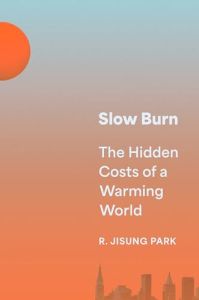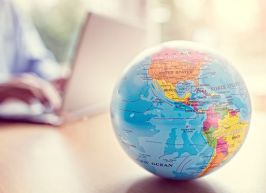Rejoignez getAbstract pour lire le résumé !

Rejoignez getAbstract pour lire le résumé !
R. Jisung Park
Slow Burn
The Hidden Costs of a Warming World
Princeton UP, 2024
Aperçu
To better address climate change, shift your focus from apocalyptic possibilities to slower, more subtle effects.
Recommendation
Thinking “statistically” — rather than relying on apocalyptic headlines, personal experience, or intuition — is vital if humanity wants to mitigate the harms of climate change, economist R. Jisung Park writes. There are many subtle ways that a slowly warming planet affects social and economic well-being, including reduced learning outcomes, lower productivity, and exacerbated socioeconomic inequity. Problem-solvers and policymakers must consider these less catastrophic “hidden costs” and seek locally focused solutions that allow people to adapt to a slowly warming planet.
Take-Aways
- Don’t just focus on the existential risks of climate change — address non-catastrophic effects, too.
- Mitigating the harms of global warming requires thinking statistically and “slowly.”
- Getting an accurate statistical view of climate change-related deaths requires new approaches.
- To grasp the true damage caused by wildfires, consider the downstream effects of smoke.
- Rising temperatures portend increased violent conflict and decreased productivity.
- Workers in poorer countries are more vulnerable to adverse effects from climate change.
- There are three reasons policymakers, economists, and problem-solvers should consider climate inequities.
- Moving into the future, communities need hope, a sense of agency, and adaptive interventions.
Summary
Don’t just focus on the existential risks of climate change — address non-catastrophic effects, too.
While those working toward climate change solutions across industries and sectors tend to focus on headline-making existential threats, humanity must also find solutions for the less catastrophic “hidden costs” of a warming planet. Many threats to human well-being will arise long before any apocalyptic scenario plays out, including a nearly imperceptible elevation of global health risks; the erosion of livelihoods in coastal and agricultural communities; a decline in learning outcomes; and lower productivity.
“The data increasingly suggests that, well before we reach the level of existential crisis for humanity, the ways climate change will make many of our activities incrementally less productive and fulfilling may warrant serious concern.”
Mitigating the subtler, often human, costs of climate change requires addressing systemic economic and social vulnerabilities and reconsidering the organization of real estate and labor markets. It also requires ensuring people have access to social safety nets, which involves mobilizing economic support for nations with less wealth. Eighty-six percent of CEOs and CFOs at the world’s largest companies agree that addressing the risks posed by climate change is important, yet 77% admit that their companies aren’t prepared to mitigate the financial risks of a changing climate, such as fallout from flooding or extreme heat waves.
Addressing more hidden climate costs also means growing awareness of “negative externalities”: how your choices can “cost” others — today and in the future. For example, your decision to drive a Hummer instead of a hybrid doesn’t just affect the air quality of people living in your community now — it also affects future generations, potentially imposing the cost of poor air quality on them.
Mitigating the harms of global warming requires thinking statistically and “slowly.”
Responding to the high-stakes problem of climate change with an eye toward preventing negative external costs requires “thinking statistically.” Calculate probabilities and averages instead of relying on your intuition and experience, which can lead to bias. As Daniel Kahneman explains, in Thinking, Fast and Slow, your mind has two decision-making systems: “System 1” makes quick, intuitive choices, while “System 2” processes information in a slower, more rational manner. Assessing the costs and benefits of various strategies to address climate change requires harnessing the power of your slow-thinking mind.
“Could it be that many of the costs of climate change are hidden from view and thus evade news coverage or even traditional recordkeeping?”
When people think slowly and statistically, the more subtle harms of a warming planet become more apparent. For example, hotter temperatures adversely affect learning outcomes in the United States — particularly those of Black and Hispanic students, who tend to attend schools that lack air-conditioned classrooms. In fact, the author’s research shows that hotter temperatures may already be responsible for as much as a 5% — or three-year — achievement gap between Black and white students. Poorer learning outcomes may, in turn, hinder economic growth. Therefore, an effect of climate change that seems small on an individual level can carry more sweeping global consequences. At the same time, this data signals something hopeful: If people take steps to ensure cooler learning environments, learning gaps will likely diminish, and more widespread and catastrophic long-term effects on learning will as well.
Getting an accurate statistical view of climate change-related deaths requires new approaches.
Accurately measuring the adverse effects of climate change is difficult. Consider heat-related deaths, for example. As the United States Centers for Disease Control (CDC) explains, classification of these deaths is challenging because heat-related illnesses may trigger a range of symptoms and worsen underlying medical conditions, resulting in frequent misdiagnosis. When heat waves overwhelm health care infrastructures, as occurred in Chicago in 1995, officials may also fail to properly classify heat-related deaths, as they may bury the dead without conducting proper autopsies.
“How we measure climate impacts matters, and there is reason to believe that our traditional tools may not be well-suited for understanding the true impacts of climate change.”
An alternate approach entails recording the number of excess deaths in an area during periods of unusually extreme heat — the “heat wave case study” approach. If the death tally increases substantially, people can reasonably attribute this increase to hotter temperatures. For example, in his writing about the Chicago heat wave, Eric Klinenberg noted the city saw roughly 700 excess deaths. While an improvement on the symptom-based approach, there are limitations to this classification method. The lack of a shared definition of what constitutes a heat wave across cities and nations makes it challenging to create standardized estimates that function across contexts.
While counting and predicting heat-related mortality rates remains a challenge, it’s clear that, like heart disease, rising temperatures may become a significant cause of death in the future. Recent estimates from the Climate Impact Lab — a consortium of researchers from the University of California, Berkeley, the University of Chicago and the Rhodium Group — suggest that by the end of this century, climate change may cause global mortality rates to rise to 73 deaths per 100,000 each year. Governments and institutions must plan accordingly.
To grasp the true damage caused by wildfires, consider the downstream effects of smoke.
It’s tempting to focus on the direct burn damage that the rise in wildfires linked with climate change causes to communities and the landscape. But there’s also a need to better quantify the hidden costs of wildfire smoke. A growing body of research strongly suggests that many social, economic, and health consequences of poor air quality, including poor learning outcomes, productivity, and mental health, are causal — not just correlational. For example, research shows that when Israeli students take exams on days with poorer air quality (exceeding 100 on the Air Quality Index, or AQI), their performance dips by about 15%. Increased air pollution is also linked to a greater risk of developing diseases such as dementia and higher hospitalization rates for patients with asthma.
“What if it was the metaphorical smoke — not the fire — that kills more of us in the end?”
Economist Marshall Burke and his research team estimate that wildfire smoke caused between 5,000 and 15,000 premature deaths in the United States each year between 2006 and 2018. However, as with heat-related deaths, official estimates don’t fully capture the total mortality rate of wild-fire related deaths: Official US records indicate that wildfires kill only about 20 to 30 people each year, but official death records fail to account for those who died prematurely due to poor air quality caused by wildfire smoke.
Rising temperatures portend increased violent conflict and decreased productivity.
Understanding the true costs of climate change requires identifying the complex societal trends associated with warmer temperatures. Research consistently shows that hotter temperatures hinder economic productivity, meaning climate change could destabilize global economies. According to one estimate, if temperatures rise 2°C in the United States, economic output could drop between 1% and 3% of GDP annually, costing the US approximately $420 to $630 billion. When economists Melissa Dell, Benjamin F. Jones, and Benjamin A. Olken analyzed data from 138 countries, they found that, for the world’s poorer countries, experiencing temperatures of 1°C hotter than average correlated with a decline in GDP growth by 1.3%.
“What is the relationship between temperature and human performance? What are the implications of a hotter climate for economic productivity and growth?”
Extreme heat is also linked to an increase in violent crime. According to researcher Matthew Ranson — who analyzed US law enforcement data between 1980 and 2009 — in months when daily temperatures hit 32.2°C or higher for a week, the rate of aggravated assaults and murders rose 3%. Reported rapes rose by more than 5%. Rising temperatures also correlate with (and potentially trigger) other unexpected consequences, ranging from harsher courtroom sentences to road rage. Preventing the harmful effects of rising temperatures on human behavior — and related inequities — requires identifying and addressing their complex causes. For example, a warming climate might lead to crime if it triggers drought, affecting people’s ability to earn money in agriculture.
Workers in poorer countries are more vulnerable to adverse effects from climate change.
Climate change disproportionately affects the world’s most vulnerable populations. For example, subsistence farmers working in the developing world often lack access to economic and social infrastructure, causing crop loss due to changes in precipitation and temperature to be more devastating. Economists Robin Burgess, Olivier Deschenes, Dave Donaldson, and Michael Greenstone note that access to banking and financial products, such as loans, could ensure that farming households “bounce back” after a few poor harvests.
“The more we can learn about what works and what doesn’t when it comes to climate adaptation, the better chance we might have in helping to protect the world’s most vulnerable from the warming we have in store.”
Climate change may increase the riskiness of work and increase gender inequality, given that workplace accidents and harassment both rise when the weather is hotter. These risks are particularly great for the 60% of the global workforce — many of whom are women — who lack “formal” work arrangements and, thus, are often excluded from traditional unemployment and health insurance protections. There’s also a need to better integrate poorer local economies into international markets. Remote locales may not have internet access or good roads, making accessing goods and services challenging when communities can’t produce or supply them themselves. If governments take steps to protect these workers and communities, individuals and national economies alike will be more insulated against climate-change-related shocks and better positioned to amplify any benefits — increased rainfall can cause floods, for example, but may be a boon for some agrarian communities.
There are three reasons policymakers, economists and problem-solvers should consider climate inequities.
Consider climate inequalities if you want to achieve the following:
- Capture the actual cost of climate change, not the average — Thinking in terms of “averages” and overemphasizing market measures like GDP can distort perceptions of climate change’s adverse effects. If, for example, wealthy nations in cooler climates experience economic gains as the planet warms, the negative consequences of climate change may seem minimal, on average, even as hotter, poorer countries see spikes in non-market measures like mortality rates. Likewise, when climate change triggers the reallocation of economic activity and income within nations, accounting only for the aggregate change may fail to capture the losses within certain communities.
- Enact protective policies that benefit everyone — If policymakers do not understand how climate change affects lower-income individuals, they may enact policies that benefit only wealthier constituents. Poorer citizens may not support climate change mitigation strategies if faced with declining economic opportunities and rising energy costs.
- Design adaptive interventions — Helping the world’s most vulnerable populations adapt to climate change cost-effectively requires addressing the reasons some countries are more vulnerable than others in the first place and designing interventions that build resilience.
Moving into the future, communities need hope, a sense of agency, and adaptive interventions.
Successful adaptation to the warming climate requires the embrace of a “messy mishmash of incremental adjustments” rather than pursuing silver bullet solutions. For example, supporting the world’s poorest households — many of whom live in countries that lack the data infrastructure to document household income levels properly — becomes possible when researchers use a wide range of data sources to create micro estimates of wealth and poverty. For example, researcher Guanghua Chi and his team used mobile phone network data, Facebook data, survey data (from the US Agency for International Development’s Demographic and Health Surveys), and satellite images to estimate and map income levels (within a 2.4-by-2.4 kilometer area) across 135 lower and middle-income countries.
“If the doomsday climate narrative invokes fear and fatalism, the non-catastrophic slow-burn perspective invites us to view climate change with sober resolve, compassion for those most vulnerable, and a sense of active hope.”
Communities should work to identify the more subtle stressors on their local environments and address those within their control. For example, the devastation of coral reefs due to warming oceans will require a coordinated global response to reduce greenhouse gases. Still, on a local level, communities can cut back on activities that harm the reefs’ resilience, such as spraying certain pesticides on agricultural land, creating runoff, and overfishing. People must remember they have agency to protect their communities. Hope is vital in an uncertain future.
About the Author
R. Jisung Park is a labor and environmental economist, and an assistant professor at the University of Pennsylvania. He has also worked as a Harvard postdoctoral fellow and a UCLA faculty member.
This document is restricted to personal use only.





















Comment on this summary